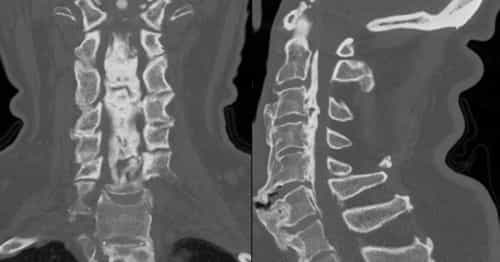

The MRI allows your doctor to look at slices of the area in question. If you have signs of nerve problems, a magnetic resonance imaging (MRI) scan, or a computed tomography (CT) scan may be ordered.

Your doctor may ask that you have x-rays of your spine, usually the mid-back. Your doctor may ask you to walk on your heels and toes. Neurological examination usually includes checking reflexes at the knees and ankles (elbows and wrists if your neck is involved), sensation, and muscle strength. Range of motion of the spine is usually evaluated, as well as tenderness of the spine or muscles next to the spine. Your doctor will ask you questions about things such as activity, urination, bowel movements, weakness, and stiffness. Your doctor will complete a history and physical examination. Squeezing of the spinal cord can cause loss of feeling and paralysis. In severe cases, the extra bone growth around the spine can cause problems with the spinal cord or nerves. This may require surgery to remove the bone spurs. The pressure can also cause a hoarse voice or difficulty in breathing. The bone spurs can put pressure on your esophagus (tube connecting the throat with the stomach), making it difficult to swallow. Ligaments and tendons where they attach to the bone near the joints develop extra bone growth.ĭifficulty swallowing ( dysphagia), or a hoarse voice, can happen when people have DISH in the neck. When DISH affects areas other than the spine, it feels like tendonitis. In addition to changes in the spine, DISH can also cause stiffness, pain, and inflammation in tendons throughout the body. Pain may be a symptom of DISH, but not always. It also seems to affect the right side of the thoracic spine more often than the left side. DISH most commonly affects the mid back, but can also affect the neck and low back. Often the decrease in motion in the spine is with side-bending. It also happens after a long period of rest. The stiffness usually happens in the morning upon waking. Stiffness and decreased range of motion are the most common symptoms of DISH. Medications that are used to treat acne may increase your risk of having DISH. The disc heights and facet joints do not show wear and tear as with other forms of osteoarthritis. Bone spurs and inflammation develop where the tendon attaches to the bones.Īlthough DISH is considered a form of osteoarthritis, it is not considered degenerative, from wear or tear. These calcification sites can lead to bone spurs in the heels, elbows, ankles, knees, and shoulders. Another common feature of DISH is that it can cause syndesmophytes (a bony outgrowth attached to a ligament) and tendonitis at sites other than the spine. This is the most common ligament that turns into bone with DISH, but it can affect other ligaments as well. Growth factors that effect the formation of calcium likely play a role.ĭISH generally affects the ligament in front of the spine called the anterior longitudinal ligament. Some researchers feel that the extra bone is made because of extra blood supply near the spine.

While the cause is unknown, there seems to be a connection with having diabetes, high blood pressure, coronary artery disease, and being over weight. Causesĭiffuse Idiopathic Skeletal Hyperostosis generally occurs in people between the ages of 50 and 60. These are the spinal ligaments that can turn into bone in Diffuse Idiopathic Skeletal Hyperostosis (DISH). There is another ligament that attaches to the back of the spine called the posterior longitudinal ligament. The ligament along the front of the spine is called the anterior longitudinal ligament. There are ligaments that help stabilized the spine. The last section of the spine is the coccyx, also know as the tail bone. The lumbar spine attaches to the sacrum which is part of the pelvis. Below the thoracic spine is your lumbar spine or low back. Below the neck is the thoracic spine or mid-back, which has the ribs attached. At the top is the neck, or cervical spine, which connects with the skull. The spine, or vertebral column, is made up of bones that stack on top of one another. It is also known as Forestier’s disease, after the name of the physician who recognized it. The most common finding of Diffuse Idiopathic Skeletal Hyperostosis (DISH) is ligaments that turn into bone. It is associated with stiffness and back pain, but often it causes no signs or symptoms. A Patient’s Guide to Diffuse Idiopathic Skeletal Hyperostosis Introductionĭiffuse Idiopathic Skeletal Hyperostosis (DISH) is a phenomenon that more commonly affects older males.


 0 kommentar(er)
0 kommentar(er)
